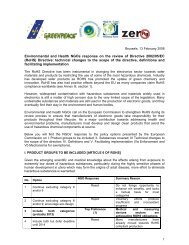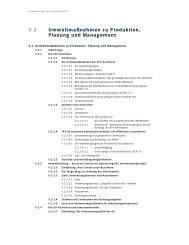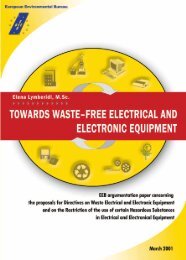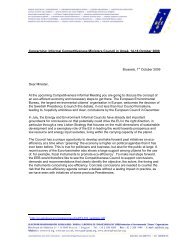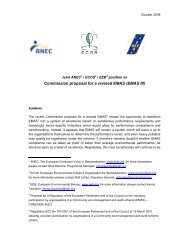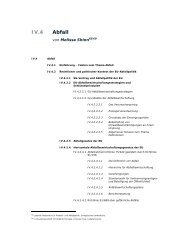Eu Mercury phase out in Measuring and Control Equipment - EEB
Eu Mercury phase out in Measuring and Control Equipment - EEB
Eu Mercury phase out in Measuring and Control Equipment - EEB
You also want an ePaper? Increase the reach of your titles
YUMPU automatically turns print PDFs into web optimized ePapers that Google loves.
REPORT FROM THE CONFERENCE “EU MERCURY PHASE OUT IN MEASURING AND CONTROL EQUIPMENT”the modulation of that <strong>and</strong> then does a calculation based upon the mean pressure determ<strong>in</strong>edfrom that, to synthesize a systolic <strong>and</strong> diastolic number.A column of mercury is the gold measurement, i.e. a direct measure of pressure. For a mercurysphygmomanometer the sources of error are the position<strong>in</strong>g of the meter stick relative to thecolumn of mercury <strong>and</strong> the metallic composition of the mercury solution (assum<strong>in</strong>g that it isnot dirty, broken, etc.). Hence, it is a direct measurement. An aneroid device can be made to berelatively accurate. However, they do drift, <strong>and</strong> if they are not properly made they will drift alot <strong>in</strong> the <strong>in</strong>itial use as the aneroid gage burns <strong>in</strong> – it takes ab<strong>out</strong> 10,000 pressure cycles for thatto happen. But all quality aneroid devices have that done <strong>in</strong> a factory before they are built <strong>and</strong>calibrated. The issue isn’t meteorological measurement accuracy. The issue is cl<strong>in</strong>ically basedupon the correlation of patient <strong>out</strong>comes <strong>and</strong> how you determ<strong>in</strong>e the pressure relative to thosepatient <strong>out</strong>comes. And the significance here is that the horizontal studies didn’t have an<strong>in</strong>dwell<strong>in</strong>g catheter. Further, COCIR/Philips commented that if we all had aortic catheters <strong>and</strong>had that measurements taken we would know what the pressure is accurate to a much greaterdegree. The issue here is how we have historically correlated auscultation to disease <strong>and</strong>determ<strong>in</strong>e when <strong>and</strong> how to treat patients based upon that determ<strong>in</strong>ation. So if the measurementmethodology is changed <strong>and</strong> if we don’t adjust the data for that, then we don’t treat the patientsproperly based upon the scientific <strong>out</strong>come studies.• University of Ill<strong>in</strong>ois, WHO Collaborat<strong>in</strong>g Center (WHO CC, UoI), who is approach<strong>in</strong>g thisdiscussion more from a cl<strong>in</strong>icians approach, commented that it would be very <strong>in</strong>terest<strong>in</strong>g toresearch what the countries that don’t use mercury sphygmomanometers (such as Sweden) haveas rates of stroke <strong>and</strong> hypertension <strong>and</strong> how that compares to the rest of <strong>Eu</strong>rope to justify thef<strong>in</strong>al conclusion. He further noted that the Fram<strong>in</strong>gham study was carried <strong>out</strong> more than 40years ago, <strong>and</strong> at the time there were some <strong>in</strong>accuracies <strong>in</strong> the process, <strong>and</strong> is not clear howthey have adjusted their data.• Karol<strong>in</strong>ska University Hospital argued that there is already a lot of uncerta<strong>in</strong>ty <strong>in</strong> the mercurymeasurement procedure. There are devices that are even more accurate than the mercurycolumn for the measurement of any type of blood pressure problem. He further remarked thatthe calibration of the measurement device can be done with an accuracy of 0,2% of the fullscale read<strong>in</strong>g <strong>in</strong> millimetre mercury.• COCIR/Philips agreed that the error the st<strong>and</strong>ard permits <strong>in</strong> an aneroid device is a lot <strong>and</strong> thereare plenty of cardiologists of the ESH <strong>in</strong> particular who th<strong>in</strong>k that this is an <strong>out</strong>rageously highnumber.Blood pressure is not a static th<strong>in</strong>g <strong>in</strong> human be<strong>in</strong>gs. Most people have a 7 or 8 millimetermodulation on their systolic pressure just due to respiration. When blood pressure is taken ittakes ab<strong>out</strong> 20 seconds between maximum <strong>in</strong>flation <strong>and</strong> the po<strong>in</strong>t of diastolic pressuredeterm<strong>in</strong>ation. That means the pressure has gone through one or two respiration cycles <strong>in</strong> thatperiod, which is why <strong>in</strong> the cardiologists protocols, they call for tak<strong>in</strong>g 2, 3 or 4 sequentialmeasurements over the course of a few m<strong>in</strong>utes. There are a lot of steps to be taken to make adiagnostic determ<strong>in</strong>ation of pressure.In a hospital, most of the pressure determ<strong>in</strong>ations are not for diagnostic purposes because youhave got a critically ill patient or you have a patient <strong>in</strong> the operat<strong>in</strong>g theatre. There you aremore look<strong>in</strong>g at a trend <strong>and</strong> you can accept a more perfunctory measurement because you donot require a highly precise measurement. But if you are be<strong>in</strong>g screened for hypertension themore precise the measurement the better the results are go<strong>in</strong>g to be <strong>in</strong> terms of plac<strong>in</strong>g you <strong>in</strong>that population curve <strong>and</strong> decid<strong>in</strong>g what treatment protocol is appropriate. And that is what isso concern<strong>in</strong>g ab<strong>out</strong> those curves from the National Institute of Health: small changes would18



